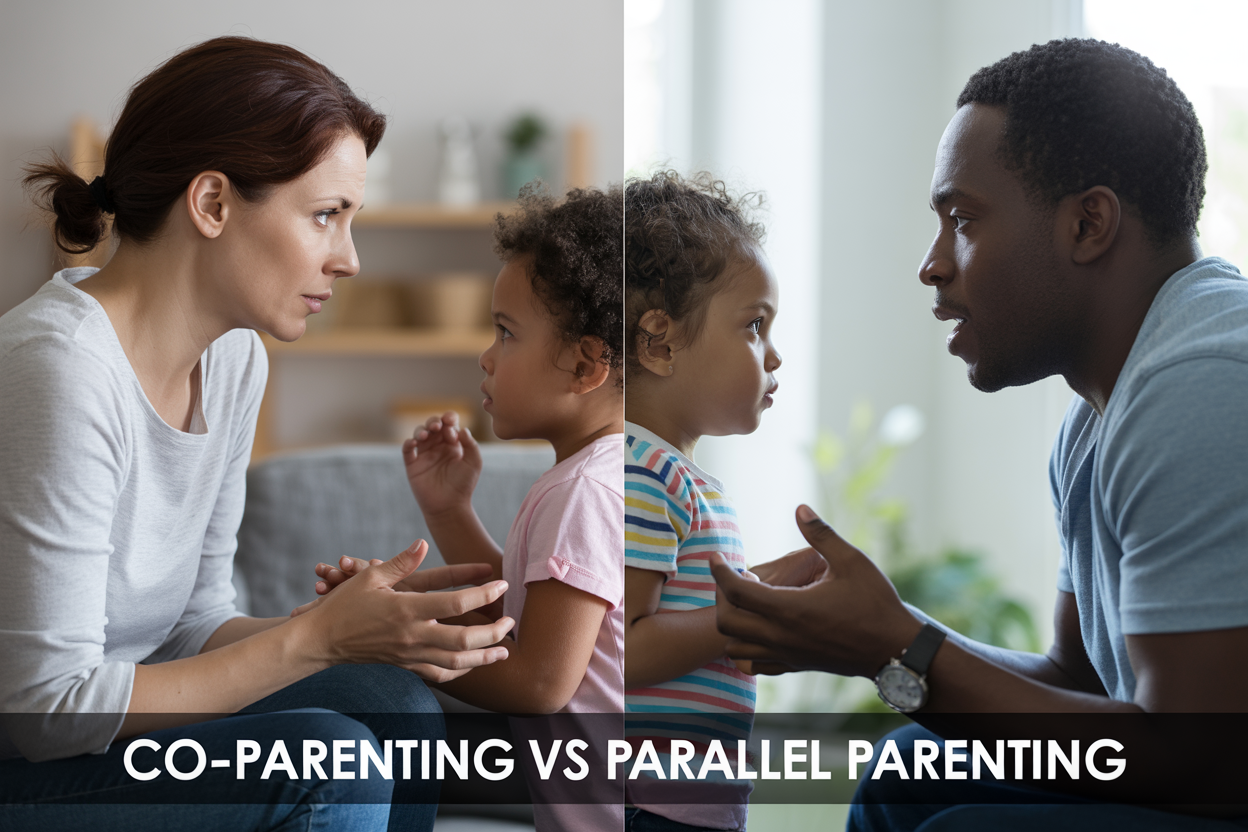When divorced parents can’t seem to agree on anything, traditional co-parenting advice often falls short. Suppose you’re dealing with a high-conflict divorce or struggling with toxic co-parenting dynamics. In that case, you’re not alone – and you have options beyond endless arguments about pickup times and school decisions.
This guide is designed for divorced parents who find themselves constantly battling with their ex-partner, family court professionals navigating complex custody cases, and anyone wondering whether parallel parenting might work better than traditional co-parenting in high-conflict situations.
We’ll break down the key differences between co-parenting vs parallel parenting approaches, helping you understand when standard divorced parents’ communication methods won’t work. You’ll learn practical parallel parenting strategies that minimize contact while keeping your kids’ needs front and center. Most importantly, we’ll walk through the specific warning signs that indicate your family might benefit from switching to this alternative approach, giving you the tools to make an informed decision about which parenting style after divorce will actually reduce conflict and protect your children’s well-being.
Understanding Co-Parenting Fundamentals
Defining cooperative parenting approaches
Cooperative parenting, also known as co-parenting, involves a unified approach where divorced or separated parents work together to raise their children. This method treats parenting as a shared responsibility that continues beyond the marriage, with both parents actively collaborating on major decisions and day-to-day child-rearing choices.
At its core, co-parenting requires former spouses to set aside personal grievances and focus on their children’s best interests. Parents coordinate schedules, share information about school events and medical appointments, and present a united front on discipline and household rules. This approach works best when both parents can communicate respectfully and maintain boundaries between their romantic relationship (which has ended) and their parenting partnership (which continues).
Successful co-parenting often involves regular check-ins, shared calendars, and consistent parenting styles across both homes. Parents might attend school events together, celebrate birthdays jointly, or even vacation as an extended family unit when appropriate.
Key benefits for children’s emotional development
Children thrive when their parents work together harmoniously after divorce. Research consistently shows that kids from cooperative parenting arrangements experience less anxiety, depression, and behavioral problems compared to those caught in parental conflict.
When parents collaborate effectively, children feel secure knowing both parents remain actively involved in their lives. They don’t have to choose sides, carry messages between homes, or worry about loyalty conflicts. This stability allows them to focus on normal childhood development rather than managing adult problems.
Co-parenting also provides children with consistent expectations and values across both households. When parents coordinate their approaches to discipline, homework, and social activities, children experience less confusion and can develop stronger self-regulation skills. They learn that despite their parents’ romantic relationship ending, the family structure still provides safety and support.
Children in cooperative parenting situations often maintain stronger relationships with both parents and extended family members. They’re more likely to feel comfortable expressing their feelings and needs without fear of causing additional conflict between their parents.
Essential communication requirements
Practical co-parenting requires clear and respectful communication between former partners. This means keeping conversations focused on the children rather than rehashing past relationship issues. Parents need to share important information about their children’s health, education, social development, and emotional needs.
Regular communication channels might include weekly phone calls, email updates, or co-parenting apps that help track schedules and share information. The key is finding methods that work for both parents while maintaining professional boundaries.
Successful co-parents learn to separate their feelings about their ex-spouse from their parenting responsibilities. They practice active listening, avoid blame language, and focus on problem-solving rather than point-scoring. When disagreements arise, they address them privately rather than involving the children.
Shared decision-making responsibilities
Co-parenting requires both parents to participate in significant decisions affecting their children’s lives. This includes choices about education, healthcare, religious upbringing, and extracurricular activities. Parents must consult each other before making significant changes that could impact the children’s routine or well-being.
Decision-making works best when parents establish transparent processes for handling different types of choices. Some decisions might require unanimous agreement, while others could be delegated to the parent with primary expertise or the one handling day-to-day care in that area.
Effective co-parents also share financial responsibilities fairly, whether through formal child support arrangements or informal agreements about specific expenses. They coordinate gift-giving for holidays and birthdays to avoid duplication or competition, and they work together to establish consistent rules about screen time, curfews, and social activities across both homes.
Exploring Parallel Parenting Strategies
Minimizing Direct Parent Contact Methods
Parallel parenting strategies center around creating physical and emotional distance between divorced parents to reduce conflict. Digital communication tools become your best friends in this approach – apps like OurFamilyWizard, AppClose, or CoParenter track all interactions and keep conversations focused on the children’s best interests. These platforms create a paper trail that family courts value, while preventing heated exchanges that often occur during face-to-face conversations.
Drop-offs and pick-ups often require creative solutions when parallel parenting is involved in high-conflict situations. Many parents choose neutral locations, such as schools, daycare centers, or community centers, where children can transition between homes without their parents interacting directly. Some families even use a “doorstep drop-off” method where one parent leaves before the other arrives. The key is finding what works for your specific situation while keeping your children’s emotional well-being at the center.
Email communication replaces phone calls and text messages, giving both parents time to craft thoughtful responses rather than reacting emotionally. This cooling-off period prevents many arguments before they start and helps maintain the structured boundaries that make parallel parenting effective.
Structured Communication Boundaries
Clear communication rules form the backbone of successful parallel parenting strategies. Establish specific topics that warrant communication, such as school events, medical appointments, emergencies, and schedule changes, which typically make the list. Everything else stays within each parent’s individual household decisions.
Time limits on responses help prevent anxiety and conflict escalation. Many parallel parenting plans specify that non-emergency communications receive responses within 24-48 hours. Emergencies get immediate attention, but parents define what constitutes a true emergency beforehand to avoid manipulation.
Business-like tone guidelines keep conversations professional and child-focused. Parents stick to facts, avoid personal commentary, and resist the urge to rehash past grievances. Think of these interactions like workplace emails – respectful, purposeful, and brief. Some families create templates for everyday situations, such as requesting schedule changes or sharing important information about their children.
Documentation becomes routine in parallel parenting. Every agreement, change, or essential conversation gets recorded. This practice protects both parents and provides clarity when memories differ about previous discussions. Many parallel parenting apps automatically save all communications, making documentation effortless.
Independent Parenting Time Management
Each parent operates their household independently without seeking approval or input from their co-parent. This autonomy reduces daily friction points that often escalate into bigger conflicts in high-conflict divorce parenting situations. Parents make decisions about bedtimes, meals, activities, and discipline within their own homes without consultation.
Scheduling flexibility happens within predetermined boundaries. While the overall custody schedule remains firm, parents can arrange internal adjustments through the communication tools without the need for lengthy negotiations. This approach works particularly well when dealing with toxic co-parenting alternatives where every small decision becomes a battleground.
Children learn to adapt to different household rules and routines, which actually builds resilience and flexibility. Parents avoid criticizing the other household’s approaches in front of their children, allowing kids to form their own relationships with each parent independently. This separation helps children avoid feeling caught in the middle of ongoing parental conflicts.
Emergency protocols get established upfront, so both parents know precisely what steps to take without needing to coordinate in crisis moments. Medical emergency contacts, school communication preferences, and decision-making authority for various situations are all clearly outlined. This preparation prevents conflicts during already stressful times and ensures children’s needs get met promptly, regardless of which parent is available.
Identifying High-Conflict Divorce Warning Signs
Recognizing Toxic Communication Patterns
When divorced parents can’t have a simple conversation without it spiraling into accusations and blame, you’re looking at toxic communication patterns that signal high-conflict situations. Watch for constant interrupting, name-calling, or bringing up past grievances during every interaction. Parents stuck in these patterns often use their children as messengers or put them in the middle of adult conflicts.
You’ll also notice one parent consistently undermining the other’s authority or making unilateral decisions without consultation. Email exchanges become novels filled with grievances, and phone calls turn into shouting matches. These toxic co-parenting alternatives become necessary when basic respect is no longer present in the relationship.
Assessing Safety Concerns for Children
Children’s well-being becomes the primary concern when evaluating high-conflict divorce parenting situations. Look for signs that kids are being exposed to verbal or physical altercations between parents. Children might start showing anxiety about transitions between homes or express fear about disappointing either parent.
Please pay attention to parents who interrogate children about the other household or ask them to keep secrets. When children begin displaying regression behaviors, sleep disturbances, or academic problems following exchanges, these red flags indicate the current arrangement isn’t protecting their emotional safety. Some situations escalate to actual safety threats, requiring immediate intervention and potentially supervised exchanges.
Evaluating Emotional Stability Factors
Emotional stability plays a crucial role in determining whether traditional co-parenting can be effective in high-conflict situations. Parents dealing with untreated mental health issues, substance abuse, or personality disorders often struggle to maintain the emotional regulation necessary for healthy co-parenting relationships.
Signs include extreme emotional reactions to minor scheduling changes, inability to separate personal feelings from parenting decisions, or using the children as emotional support systems. When one parent consistently creates drama around pickup times or uses emotional manipulation tactics, parallel parenting strategies become more appropriate than attempting collaborative approaches.
Understanding Legal Intervention Triggers
Certain behaviors automatically trigger the need for legal intervention and formal high-conflict custody arrangements. Repeated violations of custody orders, false allegations of abuse, or attempts to alienate children from the other parent require court involvement. When parents can’t agree on basic decisions about education, healthcare, or extracurricular activities, legal frameworks become necessary.
Document everything when you see patterns of contempt for court orders, harassment through excessive communication, or attempts to relocate children without permission. These situations often require choosing a parenting style after divorce through formal mediation or court-ordered parallel parenting structures rather than hoping cooperation will eventually emerge.
Comparing Effectiveness in Challenging Situations
Success rates for reducing child stress
Research shows that parallel parenting strategies consistently outperform traditional co-parenting approaches when dealing with high-conflict divorce parenting situations. Studies indicate that children experience 40-60% less stress when parents implement structured parallel parenting methods compared to attempting collaborative co-parenting in toxic environments.
The key difference lies in eliminating children’s exposure to parental conflict. When parents follow parallel parenting, which benefits include separate communication channels and minimal face-to-face interaction, kids report feeling less caught in the middle of disputes. They sleep better, show improved concentration at school, and experience fewer anxiety symptoms.
Co-parenting in high-conflict situations often backfires because repeated exposure to arguments creates chronic stress responses in children. Their cortisol levels remain elevated, affecting everything from immune function to emotional regulation. Parallel parenting breaks this cycle by creating predictable, conflict-free zones around each child’s time with both parents.
Long-term relationship improvement potential
Toxic co-parenting alternatives, such as parallel parenting, create breathing room that can actually lead to better relationships over time. About 35% of high-conflict divorced couples report improved communication after two years of parallel parenting, compared to just 15% who tried to force collaborative approaches.
The structured boundaries inherent in parallel parenting allow emotions to cool down. Parents learn to focus on their children’s needs rather than past grievances. This doesn’t mean they become friends, but many develop a businesslike respect that serves everyone better.
Some couples eventually transition from parallel to cooperative co-parenting once the initial trauma subsides. However, this transition typically takes 3-5 years and shouldn’t be forced. The beauty of parallel parenting is that it works as a permanent solution when needed.
Impact on children’s behavioral outcomes
Children in parallel parenting arrangements show significantly better behavioral outcomes than those stuck in ongoing parental conflicts. Teachers report 50% fewer behavioral incidents at school, and children demonstrate improved emotional regulation skills.
High-conflict custody arrangements managed through parallel parenting produce children who are more likely to maintain relationships with both parents into adulthood. They learn that adults can disagree while still being responsible parents, which actually provides valuable life lessons about setting boundaries and respecting others.
Academic performance also improves when children aren’t expending emotional energy managing their parents’ relationship. They can focus on age-appropriate developmental tasks rather than becoming miniature therapists or messengers between hostile adults.
Financial costs and time investments
Divorced parents’ communication methods that rely on parallel parenting often require initial investments in technology platforms, separate school communications, and sometimes coordinated therapy. These costs typically range from $500 to $2000 annually but pale in comparison to ongoing legal battles.
Traditional co-parenting attempts in high-conflict situations frequently result in repeated court appearances, mediation sessions, and custody modifications. These legal costs can easily exceed $10,000-30,000 per year, making parallel parenting a cost-effective alternative.
Time investment differs significantly between approaches. Parallel parenting requires more upfront planning and coordination, but eliminates hours of conflict resolution attempts. Parents spend their emotional energy on their children rather than fighting each other, creating effective parenting after divorce that actually works in the long term.
The key is viewing these investments as insurance policies for your family’s mental health and stability rather than additional burdens in an already challenging situation.
Determining the Right Approach for Your Family
Professional Assessment Tools and Resources
When deciding between co-parenting vs parallel parenting approaches, getting professional guidance makes all the difference. Family therapists specializing in high-conflict divorce situations can evaluate your unique circumstances and help identify which parenting style after divorce will work best for your family.
Several assessment tools help professionals determine the right path forward. The Parental Conflict Scale measures the intensity and frequency of disagreements between parents, while the Family Assessment Device evaluates overall family functioning. Child custody evaluators often use the Bricklin Perceptual Scales to understand how children perceive each parent’s relationship dynamics.
Court-appointed family mediators provide valuable insights into high-conflict custody arrangements. They observe communication patterns during sessions and can recommend specific parenting frameworks based on their observations. Many family courts now require mediation before litigation, giving parents opportunities to explore different approaches with professional support.
Mental health professionals trained in divorce recovery offer specialized programs for parents struggling with toxic co-parenting situations. These programs teach communication skills, boundary-setting techniques, and stress management strategies. Some therapists focus specifically on parallel parenting strategies, helping parents understand how to minimize direct contact while maintaining effective child care coordination.
Online assessment tools and parenting apps can supplement professional evaluations. Platforms like Our Family Wizard track communication patterns and highlight areas where conflicts frequently arise, providing data that helps determine whether cooperative co-parenting remains viable or if parallel approaches would reduce family stress.
Transitioning Between Parenting Styles Safely
Moving from traditional co-parenting to parallel parenting requires careful planning and gradual implementation. Abrupt changes can confuse children and escalate already tense situations between divorced parents.
Start by reducing direct communication between parents. Replace phone calls and face-to-face conversations with email or parenting communication apps. This creates a buffer that prevents immediate emotional reactions, allowing both parties to consider their responses. Set specific timeframes for responding to non-emergency communications; typically, 24-48 hours works well.
Establish separate parent-child relationships during this transition period. Each parent develops their own routines, rules, and traditions with the children without needing approval or input from the other parent. This doesn’t mean completely different standards, but it allows each household to function independently.
Create neutral exchange locations for child handoffs. Public places, such as school pickup areas, library parking lots, or community centers, reduce opportunities for conflict. Some families use third-party supervision services during the transition period to ensure exchanges remain peaceful.
Document the transition process carefully. Keep records of communication attempts, missed exchanges, or concerning behaviors. This documentation protects both parents and children, providing evidence if court modifications become necessary.
Children need extra support during this transition. Explain the changes in age-appropriate terms, emphasizing that both parents still love them. Consider involving a child therapist who specializes in divorce transitions to help kids process these adjustments.
Creating Sustainable Long-Term Arrangements
Building effective parenting after divorce requires realistic expectations and flexible planning. Sustainable arrangements acknowledge that family needs change as children grow and circumstances evolve.
Develop detailed parenting plans that minimize decision-making overlap. Specify which parent handles medical appointments, school meetings, extracurricular activities, and emergencies. This reduces opportunities for conflict while ensuring children’s needs get met consistently.
Financial arrangements need clear boundaries in high-conflict situations. Set up automatic child support payments to avoid monthly negotiations. Create separate accounts for children’s expenses, with each parent contributing their designated amount. Use expense-tracking apps to document costs and reimbursements without requiring direct financial discussions.
Plan for holidays, vacations, and special events well in advance. Alternating years for major holidays prevents annual conflicts. Create backup plans for when original arrangements don’t work out. Consider children’s preferences as they get older, allowing them input into scheduling decisions.
Build in review periods for your parenting arrangements. Schedule annual evaluations to assess what’s working and what needs adjustment. Sometimes families can transition back to more cooperative approaches as conflicts decrease over time. Other families find parallel parenting becomes more necessary as they recognize patterns that consistently create problems.
Establish support networks for both parents and children. This might include family therapy, support groups for divorced parents, or counseling services for children. Having professional resources available prevents minor issues from becoming major crises.
Consider geographic stability when possible. Frequent moves disrupt children’s lives and create additional coordination challenges between parents. When relocation becomes necessary, plan transitions carefully and update communication methods accordingly.
Navigating the complexities of raising children after divorce requires choosing the right approach for your unique situation. While co-parenting works well when former spouses can communicate respectfully and put their children’s needs first, parallel parenting offers a safer alternative when conflict runs deep. The key lies in honestly assessing your relationship dynamics and recognizing the warning signs that indicate when traditional co-parenting might cause more harm than good.
Your children’s emotional well-being should guide every decision you make about parenting arrangements. Suppose every interaction with your ex-partner leads to arguments or stress that spills over into your kids’ lives. In that case, parallel parenting can provide the structure and boundaries needed to create stability. Remember that successful parallel parenting isn’t about giving up on cooperation—it’s about finding a different path that protects your children while still ensuring they have meaningful relationships with both parents. Consider speaking with a family therapist or mediator who can help you evaluate which approach will serve your family best and provide the tools to make it work.
At Lass Law, our Divorce & Family Law Attorneys in North County San Diego deliver the experience and compassion needed to resolve sensitive legal matters. Whether you’re seeking guidance from a Family Law Attorney in Carlsbad, pursuing options under Divorce Law, or working with a Family Law Attorney in Escondido, we stand ready to protect your rights. Discover how our dedicated Family Law services can help you move forward with confidence.






